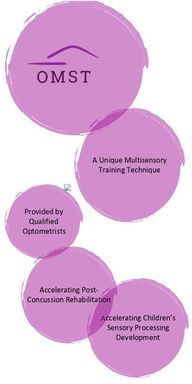
Return to flip book view
A Unique MultisensoryTraining TechniqueProvided byQualifiedOptometristsAccelerating Children’sSensory ProcessingDevelopmentAccelerating Post-Concussion Rehabilitation
What is OMST ? (optometric multisensory training) OMST is a technique used by qualified developmental/neuro-optometrists to help the brain learn or relearn multisensory processing. Multisensory processing is the ability to filter, modulate, and integrate all the senses our brain receives from the environment so that we can pay attention to what is important and ignore what isn’t. It is one of the earliest and most important functions our brain learns to do before higher brain learning can take place. OMST is a unique method involving simultaneous presentation of sensory stimulations in a safe and controlled clinical situation. This includes syntonic optometric phototherapy (specific frequencies of colored light), vestibular (motion) stimulation, auditory stimulation, somatosensory (touch and feel) input, and optometric vision therapy. OMST has two modalities: Developmental and Rehabilitative OMST-D (Developmental): enhances a child’s development of multisensory processing which is a skill that first develops in the brainstem and therefore is an unconscious skill. Multisensory processing is expected to be learned well by age three so that the child can advance to the next steps of learning (movement, balance, behavior, emotional regulation, speech, cognition). The child will more fully engage in schoolwork, home and social encounters, tutoring, optometric vision therapy, and more.
OMST-R (Rehabilitative): helps many brain-injured patients who suffer damage to this multisensory area of the brain, especially concussion and whiplash. Brain injury patients often suffer balance difficulties, lightheadedness, and dizziness. Other resulting symptoms include light sensitivity, nausea, unstable/blurry vision, motion sensitivity, and more. Consequently, this often causes anxiousness and other emotional effects. How Does OMST Do This? OMST consists of 12 consecutive days of visits to the office. The participant views a computerized light instrument while lying on a gently rotating platform and listening to modulating music tracks. This is followed by three weeks of home-based activities each morning and evening.
OMST provides a multisensory effect that is spread amongst several sensory systems. This creates opportunity for the stronger systems to support the weaker systems until all reach the balanced status that is expected of the child OR that existed before the brain injury. OMST can be incorporated before, during, or after a patient’s other interventions. Who Can Benefit From OMST? OMST has been shown to help those with: o post-concussion syndrome o chronic dizziness/imbalance o autism spectrum disorders o ADHD o behavioral difficulties o PTSD o sensory processing disorder What are OMST Success Rates? Ninety-two percent of parents report that OMST was effective for their child. Research on post-concussion patients shows that 96% report improvement within 38 days of OMST. Symptoms decrease by 40-50%. Curtis SJ. Vision Dev & Rehab 2019;5(4):235-48
What Are Patients Saying About OMST? ▪ initiates conversation, more inquisitive ▪ calmer and listens to directives ▪ following multistep directions now ▪ less frequent and intense tantrums ▪ increased expression of emotions ▪ less overwhelmed ▪ communications are “in the moment” now vs holding it in ▪ “awesome” behavioral improvements ▪ better able to attend to relationships genuinely ▪ aggression has history of being extreme; it has stopped! Mom of Jace- 9yr old ADHD, autism, LD “Thanks to the multi-sensory training my life is returning to normal. Instead of struggling with dizziness five to six days per week, I have challenges only one to two days per week.” Amy S.- Concussion patient “My mind is clearer. My dizziness is gone. I’m reading and comprehending better. I feel like I have much of my independence back and I’m not waiting for another adult to help me care for me or my family.” Kelly P.- Concussion patient “The multi-sensory therapy also helped my balance and brain fog issues. I had struggled with these issues since 2004 with little improvement. It has helped me reclaim parts of my life and improved my ability to endure daily activities.” Kurt S.- Concussion patient
Abilities Affected by OMST o Emotional and Behavioral Regulation - manage emotions and behaviors on “autopilot” o Gross & Fine Motor Control - coordinate use of muscles instinctively o Balance - maintain stable stance and gait on “autopilot” o Memory - store and retrieve words, facts, skills, concepts, and experiences o Organization - maintain orderliness in thoughts and activities o Planning - set goals and the sequences of actions to reach them o Judgement - consider potential outcomes of a situation and choose a safe and competent course of action o Mental Flexibility - shift from one way of looking at something to another o Receptive/Expressive Language - understand words and sentences/express thoughts easily and automatically o Sensory Modulation - respond to sensory environments without being overwhelmed or confused; attend to what is important at the moment and disregard what is not o Sleep – establish improved circadian rhythm for improved mental and physical stamina _________________________________________ For more info: www.omst4brains.com Find a provider here Share